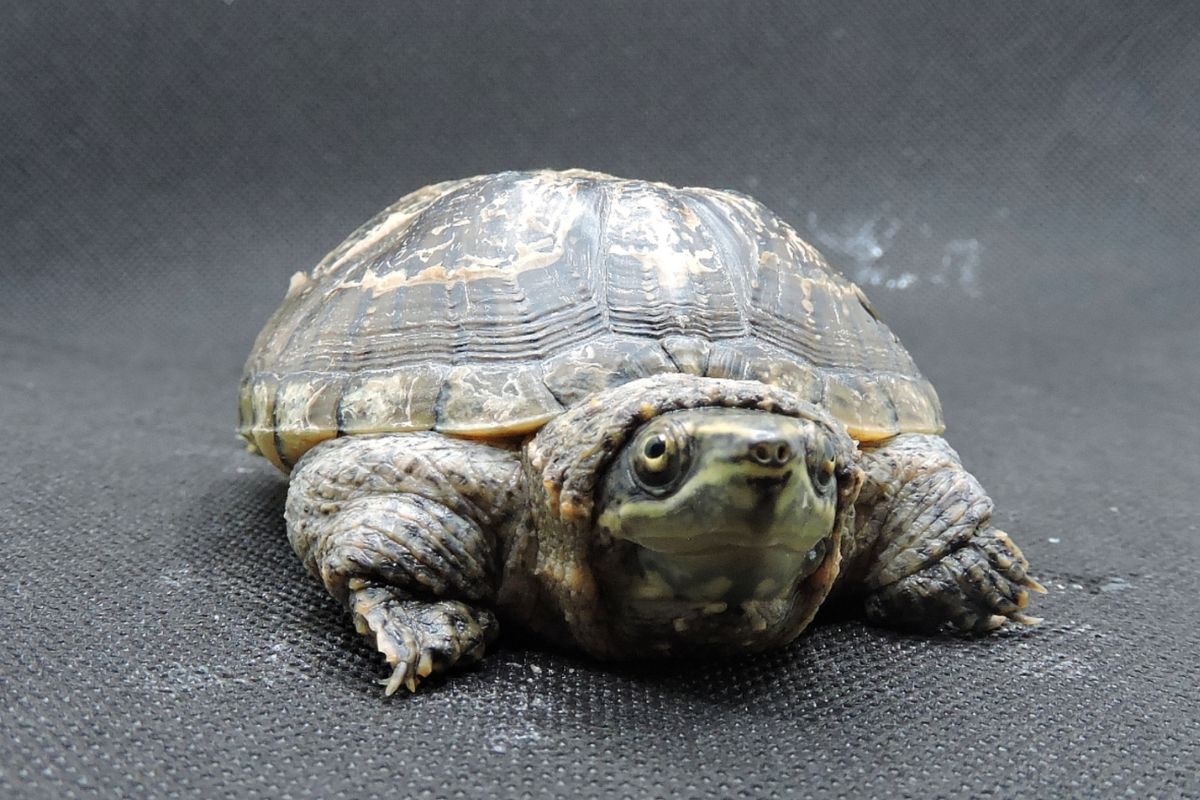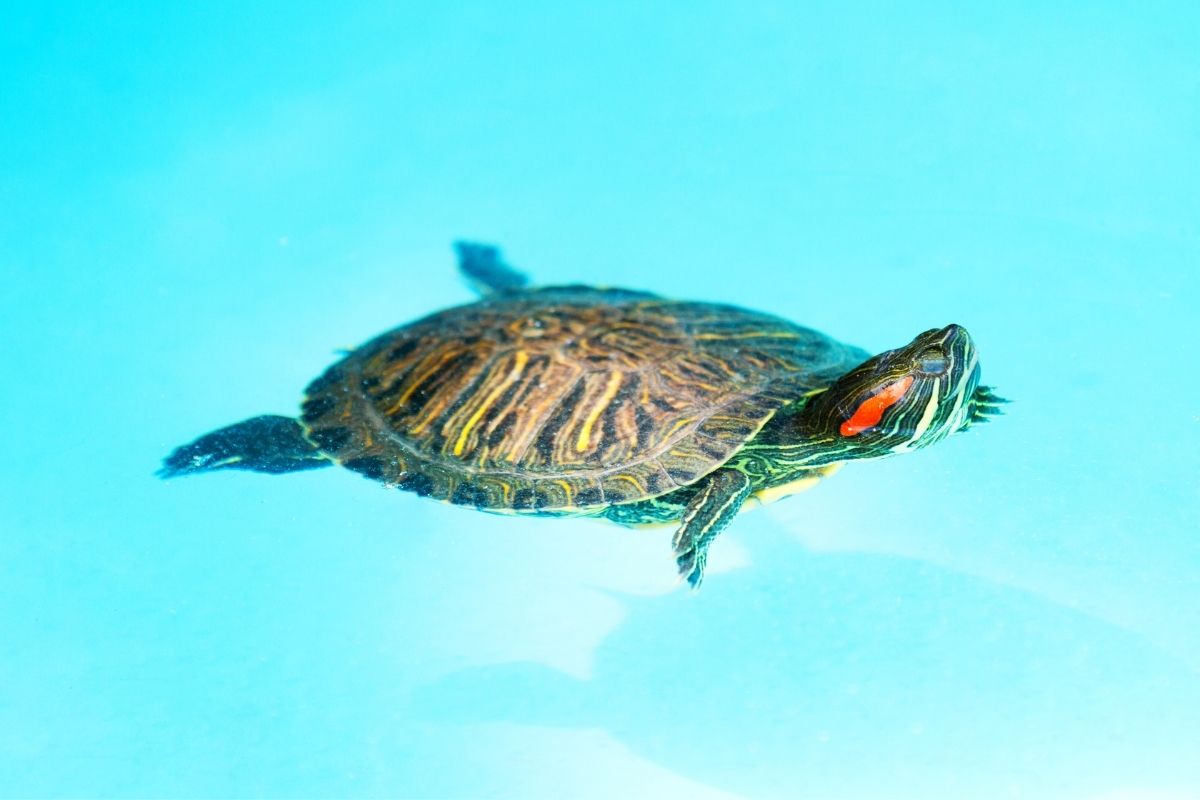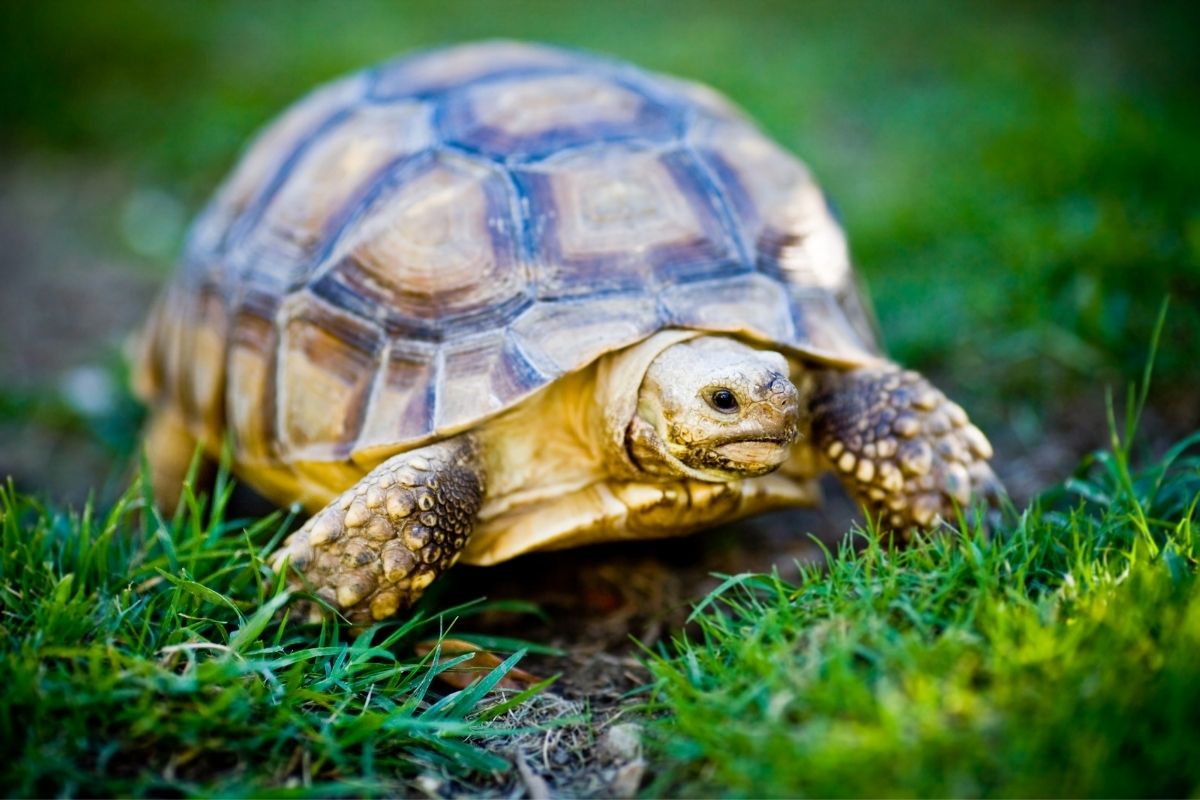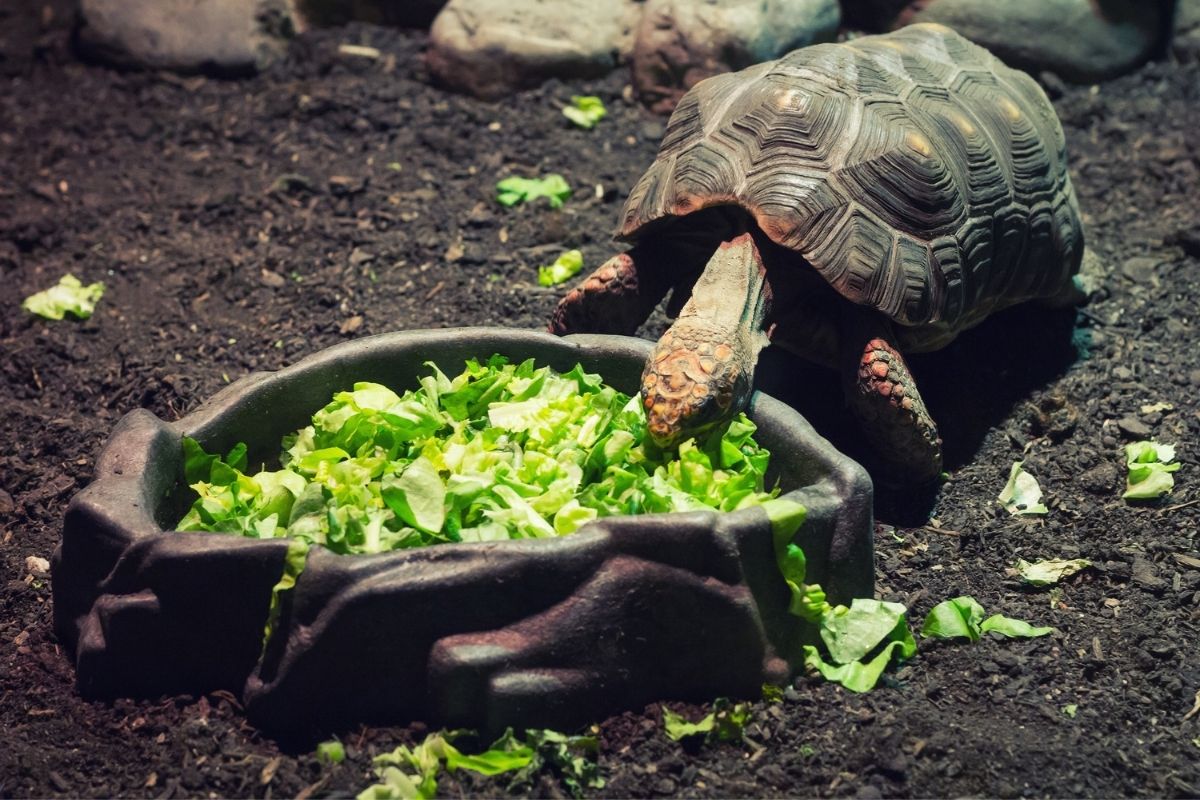Turtles are known for their slow metabolism, but some species are becoming obese due to human influence. What’s going on?

Turtles are reptiles, and they are very sensitive to temperature changes. They also eat a lot, especially during hibernation.
This means that they need to consume a lot of food to stay warm. However, as a result of poor diet and mismanagement, obesity has become a growing concern.
Just like dogs, cats, and other pets, feeding your pet turtle the wrong foods or overfeeding them can lead to obesity.
To ensure your turtle stays a healthy weight and avoids obesity, you need to make sure you feed it a balanced, healthy diet that suits its species. You should also stick to a fixed feeding routine.
To help you out, and guarantee good health for your turtle, we’re here to help. In this article, we will show you how to stop your turtle from becoming obese. You’ll also learn how to fix the problem if your turtle is already obese.
Let’s dive straight in!
The Risks Of Obesity In Turtles
Before we look at how to prevent and fix obesity in your turtle, it is important to understand just how serious things can get if your turtle became or already is obese. While obesity in turtles is actually quite rare, it isn’t that uncommon to see it at some point.
Pretty easy to spot, obese turtles will have a shell that looks far too small and fat bulges around their legs and armpits.
A turtle with fat bulges around its neck will struggle to put its head back in its shell, preventing it from sleeping properly and preventing it from protecting itself.
An obese turtle with extremely fat legs could struggle to walk on land or swim in the water. This limited mobility not only hinders the turtle’s life but also impacts the rest of its health negatively.
It could take the turtle enormous effort to even drink which puts immense pressure on its body.
Overfeeding your turtle can cause other problems too. Aside from obesity, overfeeding a turtle can put several important internal organs under pressure. An example of this is the kidneys.
If the turtle has too much protein intake, its kidneys can start to fail. This can also lead to the turtle’s shell deforming.
Ultimately, the risks associated with obesity and overfeeding in turtles can result in death.
How Is Obesity Prevented In Turtles

There are typically two main factors that cause obesity in turtles. These are overfeeding and a lack of exercise. Luckily for us, and your turtle, preventing these two factors from occurring is actually quite easy.
Lack Of Exercise
We’ll start with the lack of exercise. An active lifestyle is absolutely essential for a turtle. While they may move slow, having an active lifestyle plays a big part in ensuring a turtle lives a stress-free, healthy life.
The main reason pet turtles don’t have an active lifestyle is the result of owners only giving them a small tank or enclosure.
To guarantee your turtle gets enough exercise, you should provide it with lots of vertical and horizontal space.
There should be enough space for your turtle to roam around on land and also swim. Turtles love the water, so giving them lots of water to swim in will let them exercise more and enjoy longer swims.
Overfeeding
With regard to overfeeding, the sole reason for this is down to the foods the turtle is fed and how often they are given it.
Foods containing high levels of sugar and protein are linked to fast weight gain in turtles. Therefore, foods containing these ingredients should only be given to your turtle in moderation.
This will immediately reduce the risk of your turtle becoming obese. An example of a common food packed with sugar is fruit. Fruits are loved by turtles but are full of sugar. As a result of this, they should only make up approximately 10% of a turtle’s diet.
Turtle owners are advised to use fruits as a treat instead. That way the turtle will only eat fruit once or twice a week.
In terms of protein, omnivorous turtles like the box turtle or map turtle should be given the right amount of protein. This protein should make up roughly 30% of their overall diet.
When feeding your turtle protein, you can also encourage it to stay active by feeding it live food such as goldfish or guppies. This will make the turtle chase their food, burning a decent amount of calories in the process.
The main bulk of your turtle’s diet should be foliage and vegetables. Foods that your turtle will like and ones that will keep him/her in good shape include leafy greens like lettuce, spinach, dandelion, collard greens, and kale.
Some turtles also really enjoy carrots and squash. All of these foods are packed with nutrients that the turtles need to stay healthy.
On average, an adult turtle should be fed every two to three days. New hatchlings should be fed every day before being fed every other day when they reach a year old.
A strict food regime, a balanced diet, and an active lifestyle will keep your turtle at a good weight so be sure to get it right!
How To Fix Obesity In Turtles

If a turtle is already obese, drastic action has to be put in place to ensure the turtle has the very best chance to lose the excess weight as soon as possible.
In the next part of this article, we will detail the different things you can do to decrease your turtle’s weight and give them the best quality of life.
Feed Your Turtle The Right Amount
If your turtle is fat and continues to put on weight, you seriously need to evaluate how much you are feeding it.
A good place to start is by first reducing how often you feed your turtle. You should consider feeding your turtle once every other day before eventually feeding it once every 3 days.
As you do this, you should also start reducing the amount of food given to the turtle each time. Eventually, you should start to notice your turtle losing weight.
Depending on the size of your turtle, you can track the weight loss by taking a note of their weight using a kitchen scale.
While keeping a turtle on a strict diet, you should ensure they have no snacks and remove any food leftover from the tank. If you follow these two approaches you can’t go wrong.
- Feed your pet as much as they can eat in a 15-minute period. Remove any food they don’t manage to eat from the tanks to prevent the turtle from snacking throughout the day.
- For the second approach, try to feed your turtle a fixed amount of food. This can be easily done using a small container to carefully measure out the amount of food the turtle needs. The container should be about the same size as your turtle’s head. It should primarily be used for food and protein pellets.
The reason the second approach needs a cup similar in size to the turtle’s head is interesting. As a turtle grows, so does its head. As the turtle grows the more food it will be fed. By using this approach, you can be confident you’re always feeding the turtle the right amount.
Stick To A Strict Schedule
As we’ve already mentioned, it is super important to stick to a strict feeding schedule when feeding your turtle. This is also very important when it comes to helping your turtle lose weight.
You will need to draw up a detailed and strict food schedule that suits your turtle. Since every turtle is different, it is impossible to come up with an exact schedule, however, there are some basic rules and guidelines we can follow that will definitely help.
Generally, younglings or hatchlings should be fed once a day. Older turtles or young adults that are at least a year old should be fed every two days. Fully grown adults must be fed once every three days.
An example of a good feeding schedule for an omnivorous turtle can be found below:
- Feeding Day 1: Feed the turtle commercial pellets.
- Feeding Day 2: On feeding day two, give the turtle aquatic plants and leafy greens.
- Feeding Day 3: The turtle should now be fed animal proteins. These can include fish, superworms, or mealworms.
- Feeding Day 4 or 5: Give the turtle vegetables and some more leafy greens.
Turtles that are more carnivorous, like the musk turtle, will require a feeding schedule that contains a much higher level of animal proteins. Their diet should be approximately 25% plant-based and 75% animal protein and pellet based.
Obviously, any herbivorous turtles, such as the painted turtle or cooter turtle, should have a diet consisting of more plant-based food.
Calcium And Vitamin Supplements
Supplements can really help captive turtles get the balance of vitamins and food they need to live a healthier and slimmer lifestyle.
It is quite common for captive turtles to suffer from a lack of calcium and vitamin D deficiencies. This can be bad for the turtle as it can cause metabolic bone disease amongst other things.
This can be prevented by giving the turtle a calcium or vitamin supplement. These supplements can be sprinkled over their food twice a week.
By doing this, you are again making sure your turtle is healthy, full of energy, and happy. This will help your turtle lose weight and not put any on in the first place.
One product we like is the Zoo Med Dr. Turtle Slow-Release Calcium Block Turtle Supplement. This supplement can be dropped into the turtle’s tank water.
It will then dissolve and condition the water so that the turtle gets the calcium levels it needs. This calcium promotes good shell development. You can also find it at Chewy.com.
Foods That Turtles Can Be Fed

Now we have a much better understanding of how to prevent obesity in turtles and how to fix the problem if our turtle is already obese, we’d like to give you more information regarding the types of food you can give them.
While we have already touched on a few different types of food, we would like to give you a bigger range of options, so you can always keep your turtle happy and healthy.
Commercial Pellets And Foods
Feeding a turtle a range of different pellets and food sticks is an excellent way to provide your turtle with specialized, high-quality food that they will love.
Usually, commercial pellets and foods contain moderate amounts of carbohydrates and fats that suit your species of turtle. However, you still need to ensure you find the best pellets for your turtle.
Poor quality pellets or foods won’t provide the nutrients the turtle needs. Below, we have put some of the best commercial options on the market.
- Mazuri Turtle Diet
- Rep-Cal Box Turtle Food
- ReptoMin Baby Turtle Food Sticks
- Wardley Turtle Food Sticks
Vegetables
Turtles can eat a wide range of vegetables as they supply them with lots of nutrients, vitamins, and calcium. They are also low in sugars and carbohydrates. Having said that, some vegetables are better than others.
Here are the most popular vegetables turtles can be fed. We’ve split this section into leafy vegetables, aquatic plants, and other types of vegetables.
Leafy Greens
- Collard greens
- Red Leaf and Romaine Lettuce
- Fresh Parsley
- Kale
- Escarole
- Turnip Greens
- Dandelion
Other Vegetables
- Carrots
- Zucchini
- Squash
Aquatic Plants
- Water Lilies
- Frogbit
- Hornwort
- Pondweed
- Arrowhead
- Duckweed
- Water Hyacinth
- Spike Rush
Animal-Based Foods
Turtles really aren’t that fussy, they also love to eat animal proteins. These proteins can come from meat, insects, fish, and gastropods. Here are some awesome choices for your turtle.
Fish/Aquatic Life
- Shrimp
- Gold Fish
- Tadpoles
- Crayfish
- Mudpuppies
- Guppies
- Crustaceans
Meats
- Snails
- Small Mice
- Ground Beef
- Chicken
Insects
- Grubs
- Mealworms
- Bloodworms
- Earthworms
- Waxworms
- Superworms
- Caterpillars
- Silkworms
Fruits
We previously mentioned that fruits should only be given to turtles on rare occasions or as a treat once or twice a week. Here are some of the fruits turtles love best.
- Strawberries
- Honeydew Melon
- Cantaloupe
- Apples
- Banana
- Blueberries
To Conclude
Turtles require a very strict and specific diet to prevent them from getting fat. While obesity in turtles is relatively rare, it isn’t uncommon and can occur fairly easily if a turtle isn’t looked after properly.
Obesity can lead to turtles feeling lethargic, inactive, and unhappy. It can also prevent them from being able to move properly and put stress on their vital organs.
From reading this article, you should now know exactly how to avoid obesity in your turtle and how to fix the problem if they already are.
Regular exercise thanks to a large enclosure, live food, a well-balanced diet, and a strict feeding regime are all things that help.
Following a strict feeding schedule will ensure you don’t overfeed your turtle or give them any snacks between feeding sessions.
If your turtle is already obese, work hard to get it back in shape and healthy again. Start by reducing the food they eat and how often is a good place to start.
With all of this information at your disposal, your turtle should lead a long, healthy, and most importantly a happy life.
